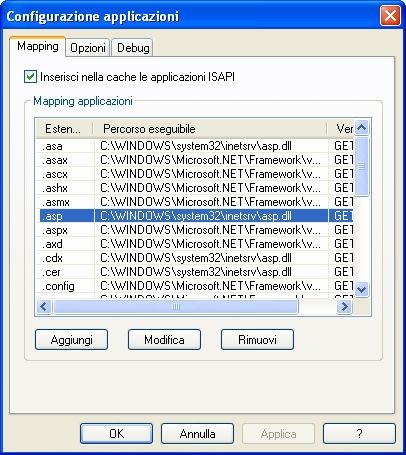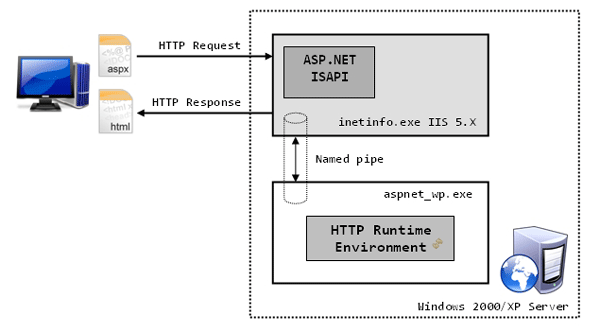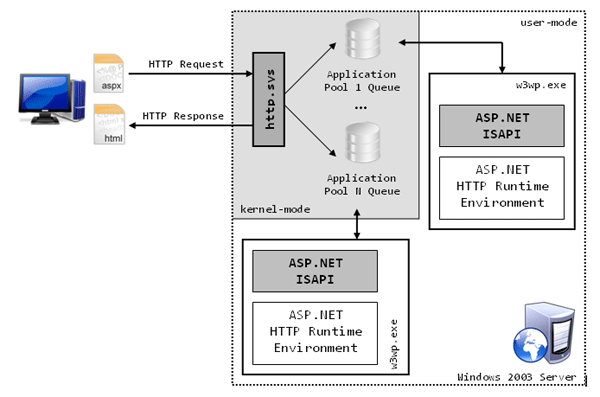ASP.NET Internals – IIS and the Process Model(http://dotnetslackers.com/articles/iis/ASPNETInternalsIISAndTheProcessModel.aspx)
In this series of articles I'm going to tackle and describe the life cycle of a web request from the early stages of its life, when it's accepted by the web server, through its processing into the ASP.NET pipeline and up to the generation of a response by the endpoints of the pipeline.
Introduction
Microsoft Active Server Pages, also known as ASP, since its first release in late 1996 provided web developers with a rich and complex framework for building web applications. As years passed its infrastructure evolved and improved so much that what is now known as ASP.NET is no longer something which resembles its predecessor. ASP.NET is a framework for building web applications, that is, applications that run over the web, where the client-server paradigm is represented mostly by a browser forwarding requests for resources of different kinds to a web server. Before the advent of dynamic server-side resource generation techniques like CGI, PHP, JSP and ASP, all web servers had to do was accept client’s requests for static resources and forward them to the requestor. When dynamic technologies started to grow up web servers became invested of greater responsibility, since they had to find a way to generate those dynamic resources on their side and return the result to the client, a task they were not formerly built for.
From a bird’s eye view, the interaction between client and server is very simple. Communications over the web occur via HTTP (Hyper Text Transfer Protocol), an application level protocol which relies on TCP and IP to transmit data between two nodes connected to the heterogeneous network known as World Wide Web.
Each dynamic server-side technology essentially leans on a particular web server implementation, and ASP.NET is tightly coupled with Microsoft’s Internet Information Server, aka IIS.
Different servers chose different ways to generate and serve dynamic resources and what we’re going to examine is how IIS does that, together with the path a request follows once on the server and back to the client.
IIS and ISAPI Extensions
As mentioned, static resources needn’t to be processed by the server; once a request for such a resource arrives, the server just retrieves its contents from the file system and sends it back to the client as a stream of byte flowing on the HTTP protocol. Static resources can be images, Javascript files, css style sheets or plain old html pages. It’s clear that the server needs to know how to distinguish between static and dynamic resource, whereas the second need to be processed somehow and not just sent back to the client. That’s where ISAPI extensions appear, where ISAPI stands for Internet Server Application Programming Interface. ISAPI extensions are modules implemented as plain old Win32 .dll, on which IIS relies to process specific resources. Mappings between ISAPI extensions and files are configured via the IIS snap-in and stored in the IIS metabase, where each file extension can be associated with a particular ISAPI extension, that is, when a request for such a file arrives, IIS handles it to the corresponding ISAPI extension, confident that it will be able to handle it.
Figure 1: Configuring ISAPI extensions mappings on IIS 5.0

ISAPI extensions obviously need to respect a common interface through which they can be called by IIS and provided the necessary data to elaborate the request and generate a response.
As Figure 1 illustrates, the .asp extension is mapped to the asp.dll ISAPI extension; at the time of ASP this component was in charge of performing all the tasks required to generate a response, that is, collecting information about the request, made available into the ASP page via the Request, Response and other common ASP intrinsic objects, parsing and executing the ASP page and returning the resulting HTML.
Actually, that was a big improvement compared to a technology like CGI, but ASP.NET takes this approach much further and introduces abstractions which totally shield the developers from having to care about what happens at this stage.
When installed, ASP.NET configures IIS to redirect requests for ASP.NET specific files to a new ISAPI extension called aspnet_isapi.dll. What this extension does is somewhat different then the former asp.dll extension, which was essentially responsible just for parsing and executing the requested ASP page. The steps taken by a generic ISAPI module to process a request are totally hidden from IIS, therefore ISAPI extension may follow different paradigms in order to process requests.
Table 1: IIS Application Mappings for aspnet_isapi.dll
| Extension | Resource Type |
| .asax | ASP.NET application files. Usually global.asax. |
| .ascx | ASP.NET user control files. |
| .ashx | HTTP handlers, the managed counterpart of ISAPI extensions. |
| .asmx | ASP.NET web services. |
| .aspx | ASP.NET web pages. |
| .axd | ASP.NET internal HTTP handlers. |
As well as the file extensions listed in Table 1, the ASP.NET ISAPI extension manages other file extensions which are usually not served to web browsers, like Visual Studio project files, source code files and config files, for example.
The ASP.NET Process Model
So far we’ve seen that when a request for an ASP.NET file is picked up by IIS, it is passed to the aspnet_isapi.dll, which is the main entry point for ASP.NET related processing. Actually, what the ISAPI extension does depends sensibly on the version of IIS available on the system, and thus the process model, which is the sequence of operations performed by the ASP.NET runtime to process the request and generate a response, may vary quite a bit.
When running under IIS 5.X, all ASP.NET-related requests are dispatched by the ISAPI extension to an external worker process called aspnet_wp.exe. The ASP.NET ISAPI extension, hosted in the IIS process inetinfo.exe, passes the control to aspnet_wp.exe, along with all the information concerning the incoming request. The communication between the two is performed via named pipes, a well known mechanism for IPC (Inter Process Communication). The ASP.NET worker process performs a considerable number of tasks, together with the ISAPI extension. They are the main authors of all the stuff that happens under the hoods of an ASP.NET request. To introduce a topic which will be discussed later, take note of the fact that each web application, corresponding to a different virtual directory hosted on IIS, is executed in the context of the same process, the ASP.NET worker process. To provide isolation and abstraction from the execution context the ASP.NET model introduces the concept of Application Domains, in brief AppDomains. They can be considered as lightweight processes. More on this later.
If running under IIS 6, on the other side, the aspnet_wp.exe process is not used, in favour of another process called w3wp.exe. Furthermore, inetinfo.exe is no longer used to forward HTTP requests to ISAPI extensions, although it keeps running for serving other protocols requests. A lot of other details change compared to the process model used by previous versions of IIS, although IIS 6 is capable of running in compatibility mode and emulate the behavior of its predecessor. A big step forward, compared to the process model used when running on top of IIS 5, is that incoming requests are in the former handled at a lower – Kernel – level and then forwarded to the correct ISAPI extension, thereby avoiding inter process communication techniques which may represent an expensive operation under a performance and resource consumption point of view. We’ll delve deeper into this topic in the following paragraphs.
IIS 5.0 Process Model
This is the default process model available on Windows 2000 and XP machines. As mentioned it consists in the IIS inetinfo.exe process listening by default on the TCP port 80 for incoming HTTP requests and queuing them into a single queue, waiting to be processed. If the request is specific to ASP.NET, the processing is delegated to the ASP.NET ISAPI extension, aspnet_isapi.dll. This, in turn, communicates with the ASP.NET worker process, aspnet_wp.exe via named pipes and finally is the worker process which takes care of delivering the request to the ASP.NET HTTP runtime environment. This process is graphically represented in Figure 2.
Figure 2: The IIS 5.0 Process Model

In Figure 2 is represented an additional element we didn’t mention yet, the ASP.NET HTTP Runtime Environment. It’s not topic of this article and will eventually be explained in a follow up article, but for the sake of this discussion the HTTP Runtime Environment can be considered as a black box where all the ASP.NET specific processing takes place, all the managed code lives and developers can actually put their hands on, from the HttpRuntime straight to the HttpHandler who will finally process the request and generate the response. This is even referred to as the ASP.NET Pipeline or HTTP Runtime pipeline.
One of the interesting points of this process model is that all the requests, once handled by the ISAPI extension, are passed to the ASP.NET worker process. Only one instance of this process is active at a time, with one exception, discussed later. Therefore all ASP.NET web applications hosted on IIS are actually hosted inside the worker process, too. However, this doesn’t mean that all the applications are run under the same context and share all their data. As mentioned, ASP.NET introduces the concept of AppDomain, which is essentially a sort of managed lightweight process which provides isolation and security boundaries. Each IIS virtual directory is executed in a single AppDomain, which is loaded automatically into the worker process whenever a resource belonging to that application is requested for the first time. Once the AppDomain is loaded – that is, all the assemblies required to satisfy that request are loaded into the AppDomain – the control is actually passed to the ASP.NET pipeline for the actual processing. Multiple AppDomains can thus run under the same process, while requests for the same AppDomain can be served by multiple threads. However, a thread doesn’t belong to an AppDomain and can serve requests for different AppDomains, but at a given time a thread belongs to a single AppDomain.
For performance purposes the worker process can be recycled according to some criteria which can be specified declaratively in the machine.config file placed in the directory C:\windows\microsoft.net\Framework\[framework version]\CONFIG. These criteria are the age of the process, number of requests served and queued, time spent idle and consumed memory. Once one of the threshold value of these parameters is reached, the ISAPI extension creates a new instance of the worker process, which will we used from then on to serve the requests. This is the only time when multiple copies of the process can be running concurrently. In fact, the old instance of the process isn’t killed, but it is allowed to terminate serving the pending requests.
IIS 6.0 Process Model
The IIS 6 process model is the default model on machines running Windows 2003 Server operating system. It introduces several changes and improvements over the IIS 5 process model. One of the biggest changes is the concept of application pools. On IIS 5.X all web applications, that is, all AppDomains, were hosted by the ASP.NET worker process. To achieve a finer granularity over security boundaries and personalization, the IIS 6 process model allows applications to run inside different copies of a new worker process, w3wp.exe. Each application pool can contain multiple AppDomains and is hosted in a single copy of the worker process. In other words, the shift is from a single process hosting all applications to multiple processes hosting each an application pool. This model is also called the worker process isolation mode.
Another big change from the previous model is the way IIS listens for incoming requests. With the IIS 5 model, it was the IIS process, inetinfo.exe, who was listening on a specific TCP port for HTTP requests. In the IIS 6 architecture, incoming requests are handled and queued at kernel level instead of user mode via a kernel driver called http.sys; this approach has several advantages over the old model and is called kernel-level request queuing.
Figure 3: The IIS 6.0 process model

Figure 3 illustrates the principal components taking part in the request processing when using the II 6 model. Once a request arrives the kernel level device driver http.sys routes it to the right application pool queue. Each queue belongs to a specific application pool, and thus to a specific copy of the worker process, which next receives the request from the queue. This approach highly reduces the overhead introduced by named pipes used in IIS 5 model since no inter process communication is taking place, but the requests are headed to the worker process directly from the kernel level driver. This has many advantages concerning reliability, too. Since running in kernel mode, the request dispatching isn’t influenced by crashes and malfunctions happing at user level, that is, in the worker processes. Thereby, even if a worker process crashes, the system is still capable of accepting incoming requests and eventually restarts the crashed process.
It’s the worker process who is in charge of loading the ASP.NET ISAPI extension, which, in turn, loads the CRL and delegates all the work to the HTTP Runtime.
The w3wp.exe worker process, differently from the aspnet_wp.exe process used in IIS 5 model, isn’t ASP.NET specific, and is used to handle any kind of requests. The specific worker process then decides which ISAPI modules to load according to the type of resources it needs to serve.
A detail not underlined in Figure 3 for simplicity reasons is that incoming requests are forwarded from the application pool queue to the right worker process via a module loaded in IIS 6 called Web Administration Service (WAS). This module is responsible for reading worker process – web application bindings from the IIS metabase and forwarding the request to the right worker process.